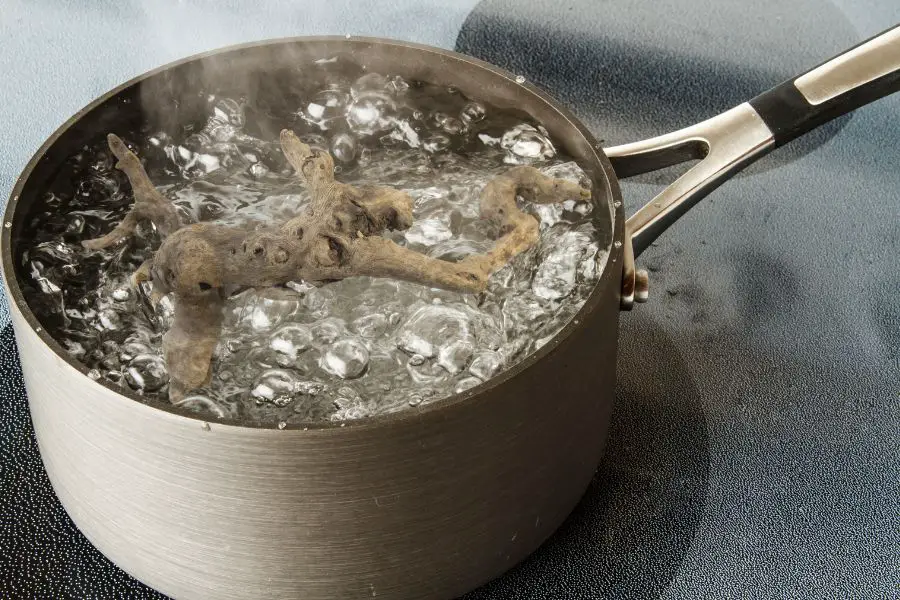Decorating an aquarium can be an exciting task. If you have just decided to use driftwood to decorate your aquarium, you should take a step back and remove tannins first.
Placing a dormant piece of driftwood inside the aquarium can give a fresh look. But, it does produce problems for your fish. Sometimes, it can even kill your fish. You may have to boil driftwood before you place it inside the aquarium.
So, how long to boil driftwood to remove tannins? Medium-sized driftwood consumes 30 minutes-2 hours based on age, moisture level, size, shape, and type. Larger driftwoods can take hours to several days to remove tannins entirely.
In this article, you will learn the best way to boil driftwood to remove tannins and also other related queries in setting up driftwood for the home aquarium.
5 Steps You MUST Follow Before Putting a Driftwood in your Aquarium
If you are new to using driftwood, Live Aquaria recommends preparing a sketch of the aquarium, cleaning driftwood, and then boiling it entirely.
Step 1. Clean
The first step is to clean the driftwood with a scrubber or a brush and dry it entirely. This is the perfect way to cure the driftwood before you boil and leave it inside the tank.
Step 2. Soak
The second step is to let the driftwood submerge entirely in a bowl of water. Let it soak for about 15 minutes. This regulates pH levels and turns them clean.
Step 3. Boil
The third step is to boil the driftwood for 15-30 minutes based on the size. If it is a small piece, you can proceed to the next step after 15 minutes. The size of the boiler is based on the volume and size of driftwood. If you are trying a small piece of driftwood, a regular heating pot is all that is needed.

Step 4. Cleanse
The fourth step is to take out the driftwood, as shown in Planted Aquarium, and pour the tannins out. Every time you boil the driftwood, tannins settle at the bottom.
Step 5. Repeat boiling
Repeat the third and fourth steps two more times. Ensure that you change the water after you pour tannins out.
When you take the driftwood out, you can see significant discoloration and a drop in pH. If you have a pH meter at home, you can notice the drop and double-confirm before you place the wood inside the aquarium.
This is perhaps the fastest way to boil driftwood to remove tannins.
Any alternatives to remove tannins from driftwood?
To use tannin-free driftwood, the only way is to clean, soak, and boil it for a specific duration.
If you have a large piece of driftwood, you need to use a large-sized pot and scrub it as much as possible before you soak it.
What if you have multiple pieces of driftwood? You can still boil them at home using the steps below.
- Clean the driftwood.
- Take a can that can hold the driftwood entirely.
- Fill the can with water and let it sit for a day.
- If you do not find it so clean, extend it to a couple more days based on the size but remember to change the water.
Tip. If you are unsure if your driftwood needs further treatment, soak it for a couple of hours and find out if it is releasing tannins and changing the color of the water to brown. If so, it needs further cleaning.
The longer you soak, the more the release of tannins.
Now, your driftwood gets ready for use inside the aquarium in a few days.
Note. There are aquariums that sell tannin-free driftwoods also. You can buy them but then boil them once to ensure that the pH level is just right for the aquarium.
How long to boil driftwood to make it sink?
For a small piece of driftwood to submerge in water, it takes 10-15 minutes. With larger pieces of driftwood, buoyancy still retains, and it takes a longer time for boiling.
In order to let the driftwood sink in the tank, you can either boil as per the size or add more weights over the driftwood so that it would submerge faster.
How long to boil wood for an aquarium?
Boiling driftwood for 1-2 hours based on the size lets it entirely sterilized and ready to use inside the aquarium.
In general, boiling wood for a long time helps balance the pH level, builds the ideal environment for the aquatic ecosystem, and removes the tannic acid produced by the wood. As a result, even though you let your fishes amidst the driftwood, they can stay free from algae and fungi growths.
Note. You need to avoid overboiling or underboiling in this process. Underboiling can retain tannins, while overboiling can affect the nature of the driftwood.
How to remove tannins from aquarium water?
If your aquarium water already contains tannins, the best solution is to use fish-friendly and heat-treated activated carbon granules, as these mitigate the development of tannins.
When you add activated carbon granules to aquarium water, it can instantly activate tannins and absorb more. As a result, the removal of tannins gets faster than ever.
As you treat the water with granules, remember to set a schedule to change the water. Sometimes, water conditions can also provide a way for more tannins to settle. This can potentially affect the pH level and hurt the fish.
What if activated carbon is not available? You can purchase chemical filter media at aquariums. These can separate tannins from water.
Conclusion
Decorating the aquarium with natural elements is an art. It needs patience when you are using materials like driftwood.
Before you directly let the driftwood sink in the water, you should boil driftwood to remove tannins and make it fish-safe. This is the key to maintaining a healthy aquarium.
While there are shortcuts to treat tannins, it is always ideal to go with the traditional procedure of cleaning and boiling driftwood, as this has long-lasting effects.

